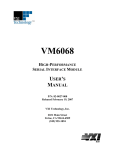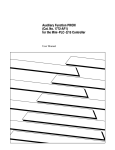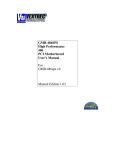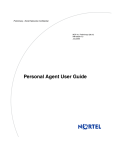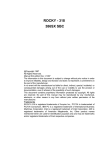Download SBC-410 Half-size 486 All-in-One CPU Card with Cache
Transcript
SBC-410
Half-size 486 All-in-One CPU Card
with Cache
FCC STATEMENT
THIS DEVICE COMPLIES WITH PART 15 FCC RULES. OPERATION IS SUBJECT TO THE FOLLOWING TWO CONDITIONS:
(1) THIS DEVICE MAY NOT CAUSE HARMFUL INTERFERENCE. (2) THIS DEVICE MUST ACCEPT ANY INTERFERENCE
RECEIVED INCLUDING INTERFERENCE THAT MAY CAUSE
UNDESIRED OPERATION.
THIS EQUIPMENT HAS BEEN TESTED AND FOUND TO
COMPLY WITH THE LIMITS FOR A CLASS "A" DIGITAL
DEVICE, PURSUANT TO PART 15 OF THE FCC RULES.
THESE LIMITS ARE DESIGNED TO PROVIDE REASONABLE PROTECTION AGAINTST HARMFUL INTERFERENCE WHEN THE EQUIPMENT IS OPERATED IN A
COMMERCIAL ENVIRONMENT. THIS EQUIPMENT GENERATES, USES, AND CAN RADIATE RADIO FREQENCY
ENERGY AND , IF NOT INSTATLLED AND USED IN ACCORDANCE WITH THE INSTRUCTION MANUAL, MAY CAUSE
HARMFUL INTERFERENCE TO RADIO COMMUNICATIONS. OPERATION OF THIS EQUIPMENT IN A RESIDENTIAL AREA IS LIKELY TO CAUSE HARMFUL INTERFERENCE IN WHICH CASE THE USER WILL BE REQUIRED
TO CORRECT THE INTERFERENCE AT HIS OWN EXPENSE.
Copyright Notice
This document is copyrighted, 1997, by AAEON Technology Inc.
All rights are reserved. AAEON Technology Inc. reserves the right
to make improvements to the products described in this manual at
any time without notice.
No part of this manual may be reproduced, copied, translated or
transmitted in any form or by any means without the prior written
permission of AAEON Technology Inc. Information provided in
this manual is intended to be accurate and reliable. However,
AAEON Technology Inc. assumes no responsibility for its use, nor
for any infringements upon the rights of third parties which may
result from its use.
Acknowledgements
ALI is a trademark of Acer Laboratories, Inc.
AMD is a trademark of Advanced Micro Devices, Inc.
AMI is a trademark of American Megatrends, Inc.
Cyrix is a trademark of Cyrix Corporation.
IBM, PC/AT, PS/2 and VGA are trademarks of International
Business Machines Corporation.
Intel and Pentium are trademarks of Intel Corporation.
Microsoft Windows ® is a registered trademark of Microsoft Corp.
SMC is a trademark of Standard Microsystems Corporation.
UMC is a trademark of United Microelectronics Corporation.
All other product names or trademarks are properties of their
respective owners.
Part No. 2007410001
Printed in Taiwan
2nd Edition
May 1997
Packing list
Before you begin installing your card, please make sure that the
following materials have been shipped:
• 1 SBC-410 CPU card
• 1 6-pin mini-DIN dual outlet adapter for keyboard and PS/2
mouse
• 1 3½" Hard disk drive (IDE) interface cable (40 pin)
• 1 2½" Hard disk drive (IDE) interface cable (44 pin)
• 1 Floppy disk drive interface cable (34 pin)
• 1 Parallel port adapter (26 pin)
• PC/104 Expansion connector converter (pin headers)
• PC/104 Module mounting supports
If any of these items are missing or damaged, contact your distributor or sales representative immediately.
Contents
Chapter 1: General Information ................................ 1
Introduction ............................................................................ 2
Features ................................................................................... 3
Specifications .......................................................................... 4
Board layout ........................................................................... 6
Card dimensions ..................................................................... 7
Chapter 2: Installation ................................................ 9
Jumpers and connectors ...................................................... 10
Locating jumpers and connectors ........................................ 11
Setting jumpers ..................................................................... 12
Safety Precations ............................................................. 13
Installing the CPU ................................................................ 13
Removing a CPU .................................................................... 13
Installing a CPU ...................................................................... 14
CPU type select (JP1, JP2, JP3) ............................................ 15
CPU Vcc select (JP7) ............................................................. 16
CPU clock select (JP6, JP8) ................................................... 16
Installing DRAM (SIMMs) .................................................. 17
Installing SIMMs .................................................................... 17
Removing SIMMs ................................................................... 17
Selecting cache memory size ................................................ 18
Cache memory select (JP11) .................................................. 18
IDE hard drive connections (Primary/ Secondary IDE) .... 19
Connecting the hard drive ....................................................... 19
IDE LED(CN3)....... . ........................................................20
Floppy drive connections (FDC CON) ................................ 22
Connecting the floppy drive .................................................... 22
Parallel port (PRINTER) ..................................................... 23
Installing the retaining bracket ................................................. 23
Power supply connections .................................................... 24
Power supply connector (POWER CON) .............................. 24
CN1,2,3,8,9,11,JP4 AND JP5 locations ................................. 24
Keyboard and PS/2 mouse connectors (KB-CON) ............ 25
Key board or PS/3 mouse select (JP8) ................................... 25
Serial ports ............................................................................ 26
RS-232/422/485 select for COMB
(JP12, JP13, JP14, JP15, JP16) ..................................... 26
RS-232/422/485 serial port connections (COMA, COMB) .... 26
RS-422 signal wiring................................................................ 28
RS-485 signal wiring................................................................ 28
Watchdog timer setup......................................................... 29
Watchdog timer time-out signal select (JP4) ........................... 29
Watchdog timer programming ................................................. 29
SMI(System management interrupt) switch (CN11) .............. 30
External Switches and LEDs ............................................. 31
Power LED and keylock (CN9) ............................................. 31
External speaker (CN10) ........................................................ 31
Reset switch (CN1) ................................................................ 32
Turbo LED (CN2) ................................................................... 32
Turbo switch (CN8) ................................................................ 32
Clear CMOS (JP9) ................................................................. 33
Flash BIOS Protect (JP10) ..................................................... 33
Flash BIOS Write-enable Voltage (JP17) ............................... 33
Chapter 3: AMIBIOS Setup ......................................... 35
General information ............................................................. 36
Starting AMIBIOS setup ......................................................... 36
AMIBIOS main menu ............................................................. 36
Using a mouse with AMIBIOS setup ...................................... 37
Using the keyboard with AMIBIOS setup .............................. 37
Standard Setup ..................................................................... 38
Advanced Setup .................................................................... 40
Chipset Setup ........................................................................ 46
Power Management Setup ................................................... 48
PCI/PnP Setup ...................................................................... 49
Peripheral Setup ................................................................... 53
Utility ..................................................................................... 56
Security .................................................................................. 57
AMIBIOS password support .................................................. 57
Anti-virus ................................................................................ 59
Default ................................................................................... 60
Original ................................................................................... 60
Optimal ................................................................................... 60
Fail-Safe .................................................................................. 60
Exiting AMIBIOS ................................................................. 61
Appendix A: Watchdog Timer Demo Program .......63
Appendix B: Installing PC/104 Modules ................... 67
Installing PC/104 modules ............................................ 68
CHAPTER
General
Information
1
This chapter gives background information on the SBC-410.
Sections include:
• Card specifications
• Board layout
Chapter 1 General Information
1
Introduction
The SBC-410 is an all-in-one CPU card that supports L2 cache
sizes from 128 KB to 512 KB (32 KB x 8, 64 KB x 8, or 128 KB x
8). This CPU card uses the M1489/M1487 chipsets, which accept
Intel, AMD, Cyrix, or other compatible 486-based CPUs. The SBC410 is fully PC/AT compatible, so your software will run without
modifications.
On-board features include two high-speed serial ports (RS-232 and
RS-232/422/485) with 16C550 UARTs, one bi-directional parallel port,
and a floppy drive controller. If program execution is halted by a
program bug or EMI, the board's 15-stage watchdog timer can
automatically reset the CPU or generate an interrupt. This ensures
reliability in unmanned or stand-alone systems.
The SBC-410 is built with two high speed local bus Enhanced IDE
controllers. This controller supports (through ATA PIO) mode 3 and
mode 4 hard disks, which enable data transfer rates of over 11 MB/
second. It connects up to four IDE devices, including large hard disks,
CD-ROM drives, tape backup drives, etc. The built-in enhanced IDE
controller provides a 4-layer 32-bit posted write-buffer and a 4-layer 32bit read-prefetch-buffer to boost IDE performance.
The SBC-410 supports 5V EDO DRAM. It also provides two 72-pin
SIMM (Single In-line Memory Module) sockets for on-board DRAM.
This gives you the flexibility to configure your system memory from 1
~ 64 MB using the most economical combination of SIMMs.
The SBC-410 also features power management to minimize power
consumption. It uses CMOS components and complies with the
"Green Function" standard.
If you need any additional functions, you can add industry-standard
PC/104 expansion modules. We provide numerous PC/104 modules to
meet your system requirements.
2
SBC-410 User's Manual
Features
• Accepts any Intel, AMD, Cyrix, or other compatible processor
• Half-size ISA bus CPU card, fully 486SX/DX/DX2/DX4/5x86/Pentium
Over Drive compatible
• Built-in 128 KB secondary cache, up to 512 KB
• Up to 64 MB of on-board DRAM; supports 5V EDO DRAM
• Built-in IDE (AT bus) hard disk drive interface, floppy drive controller
• One RS-232 and one RS-232/422/485 selectable serial port; uses
16C550 UARTs with 16-byte FIFO
• One bi-directional parallel port
• 32 to 140oF (0 to 60oC) operating temperature
• Watchdog timer, software programmable from 2 to 32 seconds
(15 steps, 2 seconds per step)
• On-board keyboard connector and/or PS/2 mouse
• IDE HDD auto-detection
• Connectors for PC/104 module expansion
• Single +5V power supply
• "Green" function, supports power management
Chapter 1 General Information
3
Specifications
• CPU: Intel 486SX/DX/DX2/DX4/Pentium Over Drive;
AMD Am486DX/DX2/DX4/5x86;
IBM/SGS/Cyrix Cx486DX/DX2/M7/5x86;
TI 486DX2/DX4
• Bus interface: ISA (PC/AT) bus
• Data bus: 32 bit
• Processing ability: 32 bit
• Chipset: ALI 1489/1487
• RAM memory: 1 MB to 64 MB, two 72-pin sockets
• Shadow RAM memory: Supports system and video BIOS up
to 256 KB in 32 KB blocks
• L2 Cache memory: On-board 128 KB, up to 512 KB (DIP package)
• Enhanced IDE HDD interface: Supports up to four enhanced IDE
(ATA-2 bus) large hard disk drives or other enhanced IDE devices.
Supports mode 3 and mode 4 hard disks (minimum data transfer
rate of 11.1 MB/sec).
• Floppy disk drive interface: Supports up to two floppy disk drives,
5.25" (360 KB and 1.2 MB) and/or 3.5" (720 KB, 1.44 and 2.88 MB).
• Bi-directional parallel port: SPP/EPP/ECP standards.
• Serial ports: One serial RS-232 port and one serial RS-232/RS-422/
RS-485 port, jumper selectable. Both with 16C550 UARTs with
16-byte FIFO buffer.
• IRQ SELECTION FOR COM PORTS:
COMA: Supports COM 1/2/3/4 & address is selectable;
COMB: Supports COM 1/2/3/4 & address is selectable;
• BIOS: AMI Flash WinBIOS
• Watchdog timer: The time interval is software selectable from 2 to 32
seconds (15 steps, 2 seconds per step). Can generate a system reset or
IRQ15.
• PC/104: 104-pin connector for a 16-bit bus
4
SBC-410 User's Manual
• DMA channels: 7
• Interrupt levels: 15
• Keyboard connector: A 6-pin mini DIN keyboard connector is located
on the mounting bracket for easy access. An on-board keyboard 5-pin
header connector is also available.
• PS/2 Mouse connector: Shared with keyboard connector.
• Bus speed: 8 MHz
• System performance: 325 MHz in 80486DX4-100 (Landmark V2.0)
• Max. power requirements: +5 V @ 2.5 A
• Power supply voltage: Single +5 V (4.75 V to 5.25 V)
• Operating temperature: 32 to 140oF (0 to 60oC); must use a cooling fan
when using a DX4-100 CPU or above
• Board size: 7.3" (L) x 4.8" (W) (185 mm x 122 mm)
• Board weight: 1.2 lbs (0.5 Kg)
• Green Function: Yes
Chapter 1 General Information
5
32K8 CACHE RAM
32K8 CACHE RAM
32K8 CACHE RAM
32K8 CACHE RAM
OEC12C887
ODIN
16V8
SMC
MAX211
MAX211
MEGA-KB
AMIBIOS
24MHz
AMERICAN MEGATRENDS
486PCI ISA
FDC37C665
M1489
ALI
14.318
M1487
SBC-410 User's Manual
ALI
6
UM61256FS-15
9644S
IMI
SC464
Board layout
SBC-410 486DX4/5X86 CPU CARD REV:.A1
185.00
178.00
73.66
PC/104 Module
26.00
Card dimensions
80.65
98.50
D4x4
19.00
19.50
122.00
Units=mm
Chapter 1 General Information
7
8
SBC-410 User's Manual
CHAPTER
Installation
2
This chapter describes how to set up the
SBC-410 hardware, including instructions on setting jumpers and connecting
peripherals, switches and indicators. Be
sure to read all safety precautions before
you begin the installation procedure.
Chapter 2 Installation
9
Jumpers and connectors
Connectors on the board link it to external devices such as hard
disk drives, a keyboard or floppy drives. In addition, the board has
a number of jumpers that allow you to configure your system to
suit your applications.
The table below lists the function of each of the board jumpers
and connectors.
Jumpers and connectors
Label
CN1
CN2
CN3
CN8
CN9
CN10
CN11
JP1, 2, 3
JP4
JP6,8
JP7
JP9
JP10
JP11
Function
Reset switch
Turbo LED
IDE LED
Turbo switch
Power LED and keylock voltage
External speaker
SMI SWITCH
CPU type select
Watchdog timer time-out signal select
CPU clock select
CPU Vcc select
Clear CMOS
Flash BIOS Protect
Cache memory select
JP12, 13, 14, 15, 16 RS-232/422/485 select
JP17
Flash BIOS Write-enable
JP18
Keyboard or PS/2 mouse select
PRIMARY IDE
Primary Enhanced IDE connector
SECONDARY IDE Secondary Enhanced IDE connector
FDC CON
FDD connector
PRINTER
Parallel connector
POWER CON
Power connector
KB-CON
External keyboard connector
KB-CON
Keyboard and/or PS/2 mouse connector
COMA
Serial port 1
COMB
Serial port 2
10 SBC-410 User's Manual
Locating jumpers and connectors
MEGA-KB
AMERICAN MEGATRENDS
486PCI ISA
AMIBIOS
ODIN
16V8
SMC
FDC37C665
IMI
SC464
14.318
JP 6,8
JP1,2,3
JP7
JP11
M1489
FDC CON
KB-COM
JP12,13,14,15,16
JP18
ALI
CN1,2,3,8,9,10,11
and JP4,5
M1487
JP9
KB-COM
ALI
JP17
COMB
OEC12C887
24MHz
PRINTER
COMA
UM61256FS-15
9644S
MAX211
JP10
MAX211
POWER CON
32K8 CACHE RAM
32K8 CACHE RAM
32K8 CACHE RAM
SIMM
SBC-410 486DX4/5X86 CPU CARD REV:.A1
SECONDARY IDE
32K8 CACHE RAM
PRIMARY IDE
Chapter 2 Installation
11
Setting jumpers
You configure your card to match the needs of your application by
setting jumpers. A jumper is the simplest kind of electric switch.
It consists of two metal pins and a small metal clip (often
protected by a plastic cover) that slides over the pins to connect
them. To "close" a jumper you connect the pins with the clip. To
"open" a jumper you remove the clip. Sometimes a jumper will
have three pins, labeled 1, 2 and 3. In this case you would connect
either pins 1 and 2 or 2 and 3.
3
1
Open
Closed
2
Closed 2-3
The jumper settings are schematically depicted in this manual as
follows:
1 2 3
Open
Closed
Closed 2-3
A pair of needle-nose pliers may be helpful when working with
jumpers.
If you have any doubts about the best hardware configuration for
your application, contact your local distributor or sales representative before you make any changes.
Generally, you simply need a standard cable to make most
connections.
12 SBC-410 User's Manual
Safety Precantions
Warning! Always completely disconnect the power cord
from your chassis whenever you are working on
it. Do not make connections while the power is
on, sensitive electronic components can be
damaged by the sudden rush of power. Only
experienced electronics personnel should open
the PC chassis.
Caution!
Always ground yourself to remove any static
charge before touching the CPU card. Modern
electronic devices are very sensitive to static
electric charges. Use a grounding wrist strap at
all times. Place all electronic components on a
static-dissipative surface or in a static-shielded
bag when they are not in the chassis.
Installing the CPU
The SBC-410 CPU card supports most 486 CPUs. The system's
performance depends on the CPU you choose. You can install or
upgrade the CPU in the board's PGA socket by following the
procedures outlined below. If your system has an existing CPU,
you need to remove it before installing the new CPU.
Removing a CPU
1. Disconnect power from the chassis, and unplug all connections to the CPU card. Then, remove the CPU card from the
chassis by following the instructions in the user's manual for
your chassis.
2. Lift the CPU out of the PGA socket. The old chip may be
difficult to remove. You may find spray chip lubricant,
designed for pin-grid-array (PGA) devices, and a chip puller
helpful. These are available at electronics hobbyists' supply
stores.
Chapter 2 Installation
13
Installing a CPU
To install the CPU, follow the instructions that came with it. If no
documentation is provided, the general procedure for installing a
CPU are outlined below:
1. Lubricate the pins on the CPU with lubricant for PGA devices.
This makes the CPU slide in much easier and greatly reduces
the chance of damaging the pins and other components.
2. Carefully align the CPU so that it is parallel to the socket.
Make sure that the notch on the corner of the CPU matches
the notch on the inside of the socket.
3. Gently push the CPU into the socket. There will probably be a
small gap between the CPU and the socket even when it is
fully seated. DO NOT USE EXCESSIVE FORCE!
When you install a new CPU, you may have to adjust other
settings on the board, such as CPU type, CPU clock and PCI
speed, to accommodate it. Make sure that the settings are correct
for your CPU. Improper settings may damage the CPU.
14 SBC-410 User's Manual
CPU type select (JP1, JP2, JP3)
JP1, JP2, and JP3 must be set to match the CPU type. The chart
below shows the proper jumper setting for their respective CPU.
CPU Type select (JP1, JP2, JP3)
Intel P24T
JP
Pin
1
2
AMD/Intel DX4 Series
Intel P24D
Intel DX2-66
AMD DE2-66
3
1
1
2
3
1
JP
1
Pin
2
3
JP
1
2
2
2
3
3
3
3
4
4
4
4
5
5
5
5
6
6
6
6
7
7
7
7
8
8
8
8
9
9
9
9
JP
1
1
2
3
4
5
6
7
8
9
2
3
Cyrix/IBM/ST/TI
DX2 Series
JP
Pin
1
1
2
3
4
5
6
7
8
9
2
3
2
3
Pin 1
1
2
Cyrix/IBM/ST
5x86 , DX4
Series
Pin
JP
Pin
*AMDX5-133/
Intel 486SX
AMD DX2-66(WB)
(default)
AMD
DX2-66(WT)
JP
Pin
1
2 3
1
2
3
4
5
6
7
8
9
Chapter 2 Installation
15
CPU Vcc select (JP7)
JP7 must be set to match its CPU type. The chart below shows the
proper jumper settings for itsVcc.
CPU Vcc select (JP7)
5.0 V
3.3 V
3.45 V*
3.6 V
JP7
2
1
2
2
1
4.0 V
1
2
1
2
1
*default
CPU clock select (JP6, JP8)
JP6 and JP8 are used to synchronize the CPU clock with the CPU
type. Set the CPU clock according to the base CPU speed.
CPU clock select (JP6, JP8)
25 MHz
2
1
1
33 MHz*
3
2
1
1
*default
16 SBC-410 User's Manual
3
40 MHz
2
1
1
3
50MHz
2
1
1
3
Installing DRAM (SIMMs)
The SBC-410 CPU card provides two 72-pin SIMM (Single Inline Memory Module) sockets and supports between 1 MB to 64
MB of RAM.
When installing SIMMs, make sure that Bank 1 is filled first.
Installing SIMMs
Note that the modules can only fit into a socket one way.
1. Insert the memory module into the socket at a moderate angle.
2. Push the module toward the vertical posts at both ends of the
socket until the module is upright, and the retaining clips at
both ends of the module click into place. When positioned
correctly, the pins on top of the vertical posts should correspond to the circular holes on the ends of the module.
3. Repeat steps 1 and 2 for each module you install.
Removing SIMMs
If you need to remove a SIMM, follow the procedures below:
1. Supporting the SIMM with a finger, use a pen or a similarly
shaped object and press one retaining clip straight down.
2. Repeat for the other side. When released, the retaining clips
will push the SIMM up and out of its upright position.
3. Carefully pull the SIMM out of the socket with your fingers.
4. Repeat the above steps for each module you remove.
Chapter 2 Installation
17
Selecting cache memory size
The SBC-410 features a 2nd level memory cache that supports
128, 256, or 512 KB of cache memory. Higher cache memory
can improve your system's performance.
The cache uses SRAM chips in three sizes: 32 KB, 64 KB and
128 KB. The on-board cache memory banks consists of four
SRAM chip sockets, each of which accepts one "Tag" chip. All
SRAM chips must have a speed of 20 ns or faster. The table below
shows the possible cache configurations:
Cache Configuration
Cache size
128 KB
256 KB
512 KB
Tag RAM
one 32 K x 8
one 32 K x 8
one 32 K x 8
Data RAM
four 32 KB x 8 SRAMs
four 64 KB x 8 SRAMs
four 128 K x 8 SRAMs
Cache memory select (JP11)
When the cache size changes, you must make sure that JP11 is set
to match the new cache memory size. The following chart shows
the proper jumper setting for each cache configuration:
Cache memory select (JP11)
128 KB*
256 KB
512 KB
2
4
2
4
2
4
1
3
1
3
1
3
*default
18 SBC-410 User's Manual
IDE hard drive connections (Primary/
Secondary IDE)
You can attach up to four Enhanced Integrated Device Electronics
hard disk drives to the SBC-410's internal controllers. The card
comes with a 40-pin and a 44-pin flat-cable piggyback cables. The
40-pin flat-cable has three identical 40-pin connectors.
Connecting the hard drive
Wire number 1 on the cable is red or blue, and the other wires are
gray.
1. Connect one end of the cable to Primary IDE or Secondary
IDE on the CPU card. Make sure that the red (or blue) wire
corresponds to pin 1 on the connector, which is labeled on the
board (on the right side).
2. Plug the other end of the cable to the Enhanced IDE hard
drive, with pin 1 on the cable corresponding to pin 1 on the
hard drive. (See your hard drive's documentation for the
location of the connector.)
Unlike floppy drives, you can make the connections with any of
the connectors on the cable. If you install two drives, you will
need to set one as the master and one as the slave. You do this
using jumpers on the drives. If you install just one drive, set it as
the master.
Chapter 2 Installation
19
IDE LED (CN3)
You can connect a LED to indicate that an IDE device is in use.
The pin assignments for this jumper are as follows:
IDE LED pin assignments (CN3)
Pin
1
2
Function
-R/W IDE
Pull high
Pin assignments
The following table lists the pin numbers and their respective
signals:
40 Pin IDE hard drive connector (PRIMARY IDE)
Enhanced IDE connector (PRIMARY IDE)
Pin
1
3
5
7
9
11
13
15
17
19
21
23
25
27
29
31
33
35
37
39
Signal
Reset
D7
D6
D5
D4
D3
D2
D1
D0
GND
N.C.
IOW
IOR
IORDY
N.C.
IRQ
A1
A0
CS0
-ACT
20 SBC-410 User's Manual
Pin
2
4
6
8
10
12
14
16
18
20
22
24
26
28
30
32
34
36
38
40
Signal
GND
D8
D9
D10
D11
D12
D13
D14
D15
N.C.
GND
GND
GND
BALE
GND
-I/O CS16
N.C.
A2
CS1
GND
44 Pin IDE hard drive connector (SECONDARY IDE)
Enhanced IDE connector (SECONDARY IDE)
Pin
1
3
5
7
9
11
13
15
17
19
21
23
25
27
29
31
33
35
37
39
41
43
Signal
IDE RESET
DATA7
DATA6
DATA5
DATA4
DATA3
DATA2
DATA1
DATA 0
SIGNAL GND
N.C.
IO WRITE
IO READ
IO CHANNEL READY
N.C.
IRQ 14
ADDR 1
ADDR 0
HARD DISK SELECT 0
IDE ACTIVE
VCC
GND
Pin
2
4
6
8
10
12
14
16
18
20
22
24
26
28
30
32
34
36
38
40
42
44
Signal
GND
DATA8
DATA9
DATA10
DATA11
DATA12
DATA13
DATA14
DATA15
N.C.
GND
GND
GND
N.C.
GND
IOCS16
N.C.
ADDR 2
HARD DISKSELECT 1
GND
MVCC
N/C
Chapter 2 Installation
21
Floppy drive connections (FDC CON)
You can attach up to two floppy disks to the SBC-410's on-board
controller. You can use any combination of 5.25" (360 KB and 1.2
MB) and/or 3.5" (720 KB, 1.44 MB, and 2.88 MB) drives.
The SBC-410 CPU card comes with a 34-pin daisy-chain drive
connector cable. On one end of the cable is a 34-pin flat-cable
connector. There are two sets of floppy disk drive connectors,
one in the middle, and one on the other end. Each set consists of a
34-pin flat-cable connector (usually used for 3.5" drives) and a
printed-circuit board connector (usually used for 5.25" drives).
Connecting the floppy drive
1. Plug the 34-pin flat-cable connector into FDC CON on the
CPU card.
2. Attach the appropriate connector on the other end of the cable
to the floppy drive(s). You can use only one connector in the
set. The set on the end (after the twist in the cable) connects
to the A: floppy. The set in the middle connects to the B:
floppy.
Pin assignments
The following table lists the pin assignments for FDC CON:
Floppy disk connector (FDC CON)
Pin
Signal
1~33(odd) GND
4, 6
Unused
10
Motor enable A
14
Driver select A
18
Direction
22
Write data
26
Track 0
30
Read data
34
Disk change
22 SBC-410 User's Manual
Pin
2
8
12
16
20
24
28
32
Signal
High density
Index
Driver select B
Motor enable B
Step pulse
Write enable
Write protect
Select head
Parallel port (PRINTER)
Normally, the parallel port is used to connect the card to a
printer. The SBC-410 includes an on-board parallel port, which
is accessed through a 26-pin flat-cable connector. The CPU
card comes with an adapter cable, which lets you use a traditional DB-25 connector. The cable has a 26-pin connector on one
end and a DB-25 connector on the other, mounted on a retaining
bracket.
Installing the retaining bracket
The retaining bracket installs at an empty slot in your system's
chassis. It provides an external port that allows your parallel
peripheral to access to the card's parallel port connector.
1. Find an empty slot in your chassis.
2. Unscrew the plate that covers the end of the slot.
3. Screw in the bracket in place of the plate.
4. Next, attach the flat-cable connector to PRINTER on the
CPU card. Wire 1 of the cable is red or blue, and the other
wires are gray. Make sure that Wire 1 connects to Pin 1 of
the PRINTER connector. Pin 1 is on the right side of
PRINTER.
Pin assignments
Parallel port connector (PRINTER)
Pin
1
3
5
7
9
11
13
15
17
Signal
Strobe
Data 1
Data 3
Data 5
Data 9
Busy
+ Select
- Error
- Select input
Pin
2
4
6
8
10
12
14
16
18~25
Signal
Data 0
Data 2
Data 4
Data 6
-Acknowledge
Paper empty
- Auto feed
- Init printer
GND
Chapter 2 Installation
23
Power supply connections
Power supply connector (POWER CON)
In single-board-computer (non-passive-backplane) applications
you will need to connect power directly to the SBC-410 board
using POWER CON. This connector is fully compatible with the
standard PC power supply connector. See the following table for
its pin assignments:
Power connector (POWER CON)
Pin
1
2
3
4
5
6
Function
N.C.
+5 VDC
+12 VDC
-12 VDC
GND
GND
CN1,2,3,8,9,10,11,JP4 AND JP5 locations
CN9
CN10
CN1
JP5(reserved)
(Pin 4 is
reserved )
CN11
CN2
CN8
24 SBC-410 User's Manual
JP4
CN3
Keyboard and PS/2 mouse
connectors (KB-CON)
The SBC-410 board provides two keyboard connectors. A 5-pin
connector supports passive backplane applications. A second 6pin mini-DIN connector on the card mounting bracket supports
single-board-computer applications. The card comes with an
adapter to convert the 6-pin mini-DIN connector, used for the
mouse, and the standard AT keyboard connector.
5-pin Keyboard or PS/2 mouse connector (KB-CON)
Pin
1
2
3
4
5
Function
K.B. clock or PS/2 clock (select by JP18)
K.B. data or PS/2 data (select by JP18)
N.C.
GND
+5 VDC
6-pin mini-DIN Keyboard or PS/2 mouse connector (KB-CON)
Pin
1
2
3
4
5
6
Function
K.B. data
PS/2 mouse data
GND
+5 VDC
K.B. clock
PS/2 mouse clock
Keyboard or PS/2 mouse select (JP18)
You can select keyboard input or PS/2mouse input for 5-pin KBCON connector.
Keyboard or PS2 mouose select (JP18)
KB*
PS/2 mouse
2
6
2
6
1
5
1
5
*default
Chapter 2 Installation
25
Serial ports
The SBC-410 offers two serial ports: one RS-232 and one RS232/422/485. Using the BIOS Peripheral Setup program, you can
select the address for each port or disable it.
The card mounting bracket has two serial port connectors. The
DB-9 connector on the top of the bracket is COMA, the RS-232
serial port. The DB-9 connector on the bottom of the bracket is
COMB, the RS-232/422/485 serial port.
RS-232/422/485 select for COMB
(JP12, JP13, JP14, JP15, JP16)
RS-232 serial ports are widely used for external input/output
devices. The RS-422 and RS-485, however, are popular for
industrial and laboratory applications because they offer high
noise resistance and long range communication (up to 4000 ft,
1200 m). The RS-422 is commnly used for two-way communication between two devices, where as RS-485 is used for communication between a single master and a network of slave modules.
COMA is the RS-232 serial port, and COMB can function as an
RS-232, RS-422, or RS-485, depending on the jumper settings
from JP12, JP13, JP14, JP15 and JP16. To select the desired
serial port type for COMB, adjust JP12, JP13, JP14, JP15, and
JP16:
JP16
JP15
3
JP12
JP16
5
JP15
1
JP14
1
JP13
RS-232*
JP14
JP12
JP13
RS-232/422/485 select for COMB (JP12, JP13, JP14, JP15, JP16)
1
1
5
3
JP16
JP15
JP14
JP12
JP13
RS-422
1
1
5
3
RS-485
*default
26 SBC-410 User's Manual
RS-232/422/485 serial port connections
(COMA, COMB)
Pin assignments
The following table shows the pin assignments for the card's
RS-232 and RS-422/485 (COMB) serial port connectors:
RS-232 (COMA, COMB)
RS-422/485 (COMB)
Pin
1
2
3
4
5
6
7
8
9
Pin
1
2
3
4
5
6
7
8
9
Signal
DCD
RX
TX
DTR
GND
DSR
RTS
CTS
RI
Signal
TX- (DTE)
TX+ (DTE)
RX+ (DTE)
RX- (DTE)
Ground
RTSRTS+
CTSCTS-
Chapter 2 Installation
27
RS-422 signal wiring
RS-422 is used for long-distance point-to-point connections. RS422 originally used four wires for one-way communication (with
devices such as display terminals or printer) but was later adopted
by the industry for simultaneous two-way communication by
doubling the number of wires.
Each pin on the first device connects to a corresponding device
on the second. Flow control lines manage the communication.
The following table shows pin connections.
Computer A
Computer B
Pin
1
2
3
4
5
6
7
8
9
Pin
4
3
2
1
5
9
8
7
6
Signal
TXTX+
RX+
RXGround
RTSRTS+
CTS+
CTS-
>
>
<
<
<
>
>
<
<
Signal
RXRX+
TX+
TXGround
CTSCTS+
RTS+
RTS-
RS-485 signal wiring
In a typical RS-485 application, the host device requests data
from a slave module then listens for the response. The host
transmits and receives data on the same pair of wires. Software
handles the flow control; no other wires are needed.
Pin assignments appear in the following table. Pins 1 and 4 share
the Data- wire. Pins 2 and 3 share the Data+ wire.
Computer A
Device B
Pin
Signal
Pin
Signal
1
4
2
3
5
TXDataRXTX+
Data+
RX+
Ground
1
4
2
3
5
TXRXTX+
RX+
Ground
28 SBC-410 User's Manual
Watchdog timer setup
Watchdog timer time-out
signal select (JP4)
If CPU processing comes to a halt because of EMI or software
bug, the watchdog timer can either reset the CPU or signal an
interrupt on IRQ15.
Watchdog timer time-out signal select (JP4)
Reset CPU*
1
2
3
IRQ15
1
2
3
* default
Watchdog timer programming
The watchdog timer must be programmed to write to I/O port
address 443 at an interval shorter than the timer's preset interval.
The timer's interval has a tolerance of ±5%, so you should
program an instruction that will refresh the timer before a timeout occurs. The following steps illustrate how you might
program the watchdog timer.
Chapter 2 Installation
29
1. Write to I/O port 443 (Hex) and designate a time-out interval.
This will enable the watchdog and set up its time-out interval.
2. Write to I/O port 080 (Hex) and any random value. This will in
turn disable the watchdog timer.
The watchdog timer-out interval can be set at 15 levels between 2
and 32 seconds. The following table shows the Hex values for the
appropriate time-out intervals:
Watchdog timer delay values
Delay time
0~2
2~4
4~6
6~8
8~10
10~12
12~14
Value (Hex)
F
E
D
C
B
A
9
Delay time
16~18
18~20
20~22
22~24
24~26
26~28
28~30
Value (Hex)
7
6
5
4
3
2
1
SMI (System Management interrupt) switch (CN11)
You can connect an extrnal switch to allow your computer to
enter suspend mode.
SMI switch (CN11)
Pin
1
2
Function
SMI
Ground
*default
30 SBC-410 User's Manual
Suspend mode Normal mode*
External Switches and LEDs
Power LED and keylock (CN9)
You can connect an LED to indicate when the CPU card is on. Pin
1 of CN9 supplies power to the LED and Pin 3 is the ground.
You can use a switch (or a lock) to disable the keyboard. In this
state the PC will not respond to any input. This is useful if you
don’t want anyone to change or stop a running program. Simply
connect the switch between Pins 4 and 5. The pin assignments
appear in the following table:
Power LED and keylock (CN9)
Pin
1
2
3
4
5
Function
LED Power (+5 V)
No Connector
Ground
Keyboard lock
Ground
External speaker (CN10)
The CPU card has its own buzzer. You can disable the internal
buzzer and connect an external speaker to CN10. Enabling the
external speaker automatically disables the internal buzzer.
External speaker (CN10)
Pin
1
2
3
4
Function
Vcc
Speaker output
Buzzer in
Speaker output
Chapter 2 Installation
31
Reset switch (CN1)
You can connect an external switch to easily reset your computer. This switch restarts your computer as if you had turned off
the power then turned it back on. The following table shows the
pin assignments for the CN1.
Reset switch (CN1)
Pin
1
2
Function
Ground
Reset
Turbo LED (CN2)
You can connect a LED indicator across CN2 to indicate when
the CPU is in Turbo mode. Marks on the circuit board indicate
LED polarity (the pin on the left is positive).
Turbo LED (CN2)
Pin
1
2
Function
Turbo
Ground
Turbo switch (CN8)
You can connect a switch across the pins of CN8 to change the
CPU speed between Turbo and non-Turbo mode. When you
leave the pins open, the CPU card operates at full speed. When
you close the pins, the card operates at slow speed for compatibility with older software.
Turbo switch (CN8)
Pin
1
2
Function
- Deturbo
Pull low
*default
32 SBC-410 User's Manual
Low speed
High Speed *
Clear CMOS (JP9)
You can connect an external switch to clear CMOS. This switch
closes JP9 and turns off the power, at which time the CMOS
setup can be cleared.
Clear CMOS (JP9)
Protect*
Clear CMOS
*default
Flash BIOS Protect (JP10)
You can set the JP10 to protect BIOS write-enable. The configuration is as follows:
Flash BIOS Protect (JP10)
Write protect*
Write-enable
*default
Flash BIOS Write-enable Voltage (JP17)
This jumper sets the voltage supplied to the Flash BIOS Writeenable. The figure below shows the proper jumper settings for
both 5 V and 12 V voltage.
Flash BIOS Write-enable Voltage (JP17)
5V*
1
12 V
3
1
3
*default
Chapter 2 Installation
33
34 SBC-410 User's Manual
CHAPTER
AMIBIOS Setup
3
This chapter describes the cards diagnostic tests and how to set BIOS configuration data in a Windows environment.
Chapter 3 AMIBIOS setup
35
General information
AMIBIOS Setup configures system information that is stored in
CMOS RAM. Unlike conventional BIOS setup programs, AMIBIOS features a graphical user interface that is easy to use.
Starting AMIBIOS setup
As POST executes, the following appears;
Hit <DEL> if you want to run SETUP
Press <DEL> to run AMIBIOS setup.
AMIBIOS main menu
The AMIBIOS setup screen appears as follows:
36 SBC-410 User's Manual
Using a mouse with AMIBIOS SETUP
AMIBIOS Setup can be accessed via keyboard, mouse, or pen.
The mouse click functions are:
single click to change or select both global and current fields
double click to perform an operation in the selected field
Using the keyboard with AMIBIOS setup
AMIBIOS Setup has a built-in keyboard driver that uses simple
keystroke combinations:
Keystroke
<tab>
è , ç, é , ê
Function
Move to the next window or field.
Move to the next field to the right,
left, above, or below.
<ENTER>
Select in the current field.
+
Increments a value.
Decrements a value.
<ESC>
Close the current operation and return to
previous level.
<PgUp>
Return to the previous page.
<PgDn>
Advance to the next page.
<Home>
Return to the beginning of the text.
<End>
Advance to the end of the text.
<ALT>+H
Access a help window.
<ALT>+<Spacebar> Exit AMIBIOS Setup.
Alphabetic keys
A to Z are used in the Virtual keyboard, and
are not case sensitive.
Numeric keys
0 to 9 are in the Virtual keyboard and
Numeric keypad.
Chapter 3 AMIBIOS setup
37
Standard Setup
The AMIBIOS Setup options described in this section are
selected by choosing the Standard icon from the AMIBIOS Setup
main menu selection screen, as shown below.
The Standard Setup screen appears:
Pri Master, Pri Slave, Sec Master and Sec Slave
Choose these icons to configure the hard disk drive named in the
option. When you click on an icon, the following parameters are
listed: Type, LBA/Large Mode, Block Mode, 32Bit Mode, and PIO
Mode. All parameters relate to IDE drives except Type.
38 SBC-410 User's Manual
User-Defined Drive
If you are configuring a SCSI drive or an MFM, RLL, ARLL, or
ESDI drive with drive parameters that do not match drive types 146, you can select the User in the Type field. You must then enter
the drive parameters on the screen that appears. The drive
parameters include:
Cylinder (number of cylinders),
Hd (number of headers),
WP(starting write precompensation cylinder),
Sec (number of sectors),
Size (drive capacity).
Date, Day and Time Configuration
Select the Date and Time icon in the Standard setup. The current
values for each category are displayed. Enter new values through
the keyboard.
Floppy A, Floppy B
Select these icons to configure the type of floppy drive that is
attached to the system: 360 KB 5 1/4", 1.2 MB 5 1/4", 720 KB 3 1/2",
1.44 MB 3 1/2", and/or 2.88 MB 3 1/2". The settings have not been
pre-installed.
Chapter 3 AMIBIOS setup
39
Advanced Setup
Select the Advanced icon from the AMIBIOS Setup main menu to
enter Advanced setup.
40 SBC-410 User's Manual
Quick Boot:
Set this option to Enabled to instruct AMIBIOS to boot quickly
when the computer is powered on. This option replaces the old
Above 1 MB Memory Test Advanced Setup option. The default
setting is Disabled.
Setting
Disabled
Description
Enabled
AMIBIOS does not test system memory above 1 MB.
AMIBIOS test all system memory. AMIBIOS waits up
to 40 seconds for a READY signal from the IDE hard
disk drive. AMIBIOS waits for .5 seconds after sending
a RESET signal to the IDE drive to allow the IDE drive
time to get ready again. AMIBIOS checks for a <Del>
key press and runs AMIBIOS Setup if the key has
been pressed.
AMIBIOS does not wait up to 40 seconds for a
READY signal from the IDE hard disk drive. If a
READY signal is not received immediately from the
IDE drive, AMIBIOS does not configure that drive.
AMIBIOS does not wait for .5 seconds after sending
a RESET signal to the IDE drive to allow the IDE drive
time to get ready again.
You cannot run AMIBIOS Setup at system boot,
because there is no delay for the Hit <Del> to run
Setup message.
Boot Up Sequence:
This option sets the sequence of boot drives (floppy drive A:, hard
disk drive C:, or CD-ROM drive) that the AMIBIOS attempts to
boot from after AMIBIOS POST completes. The settings are
C:,A:,CDROM, CDROM,A:,C:, or A:,C:,CDROM. The default
settings are A:,C:,CDROM.
Boot Up Num Lock:
Set this option to Off to turn the Num Lock key off when the
computer is booted so you can use the arrow keys on both the
numeric keypad and the keyboard. The settings are On or Off. The
default settings are on.
Chapter 3 AMIBIOS setup
41
Turbo Switch:
Set this option to Enabled to permit AMIBIOS to control the
hardware turbo (speed) switch. The settings are Enabled or
Disabled.
Floppy Drive Swap:
Set this option to Enabled to permit drives A: or B: to be
Swapped. The settings are Enabled or Disabled. The default
settings are Disabled.
Floppy Drive Seek:
Set this option to Enabled to specify that floppy drive A: will
perform a Seek operation at system boot. The settings are Enabled
or Disabled. The Optimal and Fail-Safe default settings are
Disabled.
Mouse Support:
When this option is set to Enabled, AMIBIOS supports a PS/2type mouse. The settings are Enabled or Disabled. The default
settings are Enabled.
System Keyboard:
This option specifies that a keyboard is attached to the computer.
The settings are Present or Absent. The Optimal and Fail-Safe
default settings are Present.
Primary Display:
This option specifies the type of display monitor and adapter
in the computer.
The settings are Mono, CGA40X25, CGA80X25, VGA/EGA, or
Absent. The Optimal and Fail-Safe default settings are VGA/
EGA.
42 SBC-410 User's Manual
Password Check:
This option enables password checking every time the computer
is powered on or every time AMINBIOS Setup is executed. If
Always is chosen, a user password prompt appears every time the
computer is turned on. If Setup is chosen, the password prompt
appears every time AMIBIOS is executed. The Optimal and
Fail-Safe defaults are Setup.
Parity Check:
Set this option to Enabled to check the parity of all system memory.
The settings are Enabled or Disabled. The Optimal and Fail-Safe
default settings are Disabled.
OS/2 Compatible Mode:
Set this option to Enabled to permit AMIBIOS to run with IBM OS/
2. The settings are Enabled or Disabled. The default settings are
Disabled.
Wait for F1 if Error:
AMIBIOS POST error messages are followed by:
Press <F1> to continue
If this option is set to Disabled, AMIBIOS does not wait for you to
press the <F1> key after an error message. The settings are
Enabled or Disabled. The Optimal and Fail-Safe default settings
are Enabled.
Hit 'Del' Message Display:
Set this option to Disabled to prevent :
Hit <DEL> if you want to run Setup
from appearing on the first AMIBIOS screen when the computer
boots. The settings are Enabled or Disabled. The Optimal and
Fail-Safe default settings are Enabled.
Chapter 3 AMIBIOS setup
43
Internal Cache
This option specifies the caching algorithm used for L1 internal
cache memory. The setting are:
Setting
Disabled
WriteBack
Description
Neither L1 internal cache memory on the
CPU nor L2 secondary cache memory is
enabled.
Use the write-back caching algorithm.
External Cache
This option specifies the caching algorithm used for L2 secondary
(external) cache memory. The settings are:
Setting
Disabled
WriteBack
WriteThru
Description
Neither L1 internal cache memory on the
CPU nor L2 secondary cache memory is
enabled.
Use the write-back caching algorithm.
Use the write-through caching algorithm.
System BIOS Cacheable
When this option is set to Enabled, the contents of the F0000h
system memory segment can be read from or written to L2 secondary cache memory. The contents of the F0000h memory segment are
always copied from the BIOS ROM to system RAM for faster
execution.
The settings are Enabled or Disabled. The Fail-Safe default setting
is Disabled.
Numeric Processor Test
Set this option to Enbabled to permit numeric processor to be
tested. The deault setting is Disabled.
Hard Disk Delay
This option allows you to select hard disk delay time from 5 Sec to
15 Sec. The default setting is Disabled.
44 SBC-410 User's Manual
C000,16k Shadow
C400,16k Shadow
C800,16k Shadow
CC00,16k Shadow
D000,16k Shadow
D400,16k Shadow
D800,16k Shadow
DC00,16k Shadow
E000,64k Shadow
These options control the location of the contents of the 16KB of
ROM beginning at the specified memory location. If no adapter
ROM is using the named ROM area, this area is made available to
the local bus. The settings are:
Setting
Enabled
Disabled
Description
The contents of the named ROM area are
written to the same address in system
memory (RAM) for faster execution, if an
adapter ROM will be using the named ROM
area. Also, the contents of the RAM area can
be read from and written to cache memory.
The video ROM is not copied to RAM. The
contents of the video ROM cannot be read
from or written to cache memory.
Chapter 3 AMIBIOS setup
45
Chipset Setup
The AMIBIOS Setup options described in this section are
selected by choosing the Chipset icon from the AMIBIOS setup
main menu,shown below.
The following is an option list offered by Chipset Setup
Chipset setup options
Function
Auto Configuration Function
AT Bus Clock
DRAM Read Timing
46 SBC-410 User's Manual
Options
Disabled/Enabled
7.16 MHz
CPU Bus Speed/3
CPU Bus Speed/4
CPU Bus Speed/5
CPU Bus Speed/6
CPU Bus Speed/8
Slow
Normal
Faster
Fastest
Function
DRAM Write Timing
SRAM Type
SRAM Read Timing
SRAM Write Timing
Memory Parity Check
DRAM Hidden Refresh
DRAM Refresh Period Setting
Memory Hole at 15-16 M
ISA I/O Recovery
ISA I/O Recovery Time
System Hidden Refresh
Cx5x86 Linear Wrapped Mode
Options
Slow
Normal
Faster
Fastest
2-1-1-1
3-1-1-1
3-2-2-2
4-2-2-2
Fast
Normal
Fast
Normal
Disabled
Enabled
Disabled
Enabled
15 ms
30 ms
60 ms
120 ms
Disabled
Enabled
Disabled
Enabled
0.5 ms
1.0 ms
1.5 ms
2.0 ms
2.5 ms
3.0 ms
3.5 ms
15 ms
30 ms
60 ms
120 ms
Disabled
Enabled
Chapter 3 AMIBIOS setup
47
Power Management Setup
As part of the "Green" function, the Power Management setup
offers options to help reduce power consumption. To see the
options in this group, choose the Power Management Setup icon
from the AMIBIOS Setup main menu.
Power Management Mode/APM Funtion
Set this option to Enabled to enable the power management and
APM (Advanced Power Management) features.
The settings are Enabled or Disabled. The default settings are
disabled.
48 SBC-410 User's Manual
PCI/PnP Setup
PCI/PnP Setup options are displayed by choosing the PCI/PnP
Setup icon from the AMIBIOS Setup main menu. All PCI/PnP
Setup options are described in this section.
Plug and Play Aware OS
Set this option to Yes if the operating system installed in the
computer is Plug and Play-aware. AMIBIOS only detects and
enables PnP ISA adapter cards that are required for system boot.
The Windows 95 operating system detects and enables all other
PnP-aware adapter cards. Windows 95 is PnP-aware. Set this option
to No if the operating system (such as DOS, OS/2, Windows 3.x)
does not use PnP.
You must set this option correctly or PnP-aware adapter cards
installed in your computer will not be configured properly.
The settings are No or Yes. The Optimal and Fail-Safe default
settings are Yes.
Chapter 3 AMIBIOS setup
49
PCI Latency Timer (in PCI Clocks)
This option sets latency of all PCI devices on the PCI bus. The
settings are in units equal to PCI clocks. The settings are 32, 64,
96, 128, 160, 192, 224, or 248. The Optimal and Fail-Safe default
settings are 64.
VGA Locate Bus
This option allows you to select VGA bus. The setting is PCI and
ISA (Default).
CPU to PCI Write Buffer
This option sets the write buffer between CPU and PCI bus. The
default setting is Enabled.
Byte Merge
Set this option to Enabled to specify the IDE contraller to
transmit data with byte merge. This will improve the data
transimitting performonce.
PCI IDE BusMaster
Set this option to Enabled to specify that the IDE controller on the
PCI local bus has bus mastering capability. The settings are
Disabled or Enabled. The Optimal and Fail-safe default settings are
Disabled.
Offboard PCI IDE Card
This option specifies if an offboard PCI IDE controller adapter card
is used in the computer. You must also specify the PCI expansion
slot on the motherboard where the offboard PCI IDE controller
on the motherboard is automatically disabled. The settings are
Auto, Slot1, Slot2, Slot3, Slot4, Slot5 or Slot6.
If Auto is selected, AMIBIOS automatically determines the correct
setting for this option. The Optionmal and Fail-Safe default settings
are Auto.
50 SBC-410 User's Manual
PCI
PCI
PCI
PCI
Slot1
Slot2
Slot3
Slot4
IRQ
IRQ
IRQ
IRQ
Priority
Priority
Priority
Priority
This option sets PCI slot IRQ priority.
The selectable settings are Auto,3,4,5,7,9,10,11. The default setting is Auto.
IRQ3
IRQ4
IRQ5
IRQ7
IRQ9
IRQ10
IRQ11
IRQ14
IRQ15
These options specify the bus that the named interrupt request
lines (IRQs) are used on. These options allow you to specify IRQs
for use by legacy ISA adapter cards.
These options determine if AMIBIOS should remove an IRQ from
the pool of available IRQs passed to BIOS configurable devices.
The available IRQ pool is determined by reading the ESCD
NVRAM. If more IRQs must be removed from the pool, the end
user can use these PCI/PnP Setup options to remove the IRQ by
assigning the option to the ISA/EISA setting. Onboard I/O is
configurable by AMIBIOS. The IRQs used by onboard I/O are
configured as PCI/PnP.
The settings are PCI/PnP or ISA/EISA. The Optimal and Fail-Safe
default settings are PCI/PnP.
Chapter 3 AMIBIOS setup
51
Reserved Memory Size
This option specifies the size of the memory area reserved for
legacy ISA adapter cards.
The settings are Disabled, 16K, 32K, or 64K and Fail-Safe default
settings are Disabled.
Reserved Memory Address
This option specifies the beginning address (in hex) of the reserved
memory area. The specified ROM memory area is reserved for use
by legacy ISA adapter cards.
The settings are C0000, C4000, C8000, CC000, D0000, D4000,
D8000, or DC000.
52 SBC-410 User's Manual
Peripheral Setup
Peripheral Setup options are displayed by choosing the Peripheral Setup icon from the AMIBIOS Setup main menu. All Peripheral Setup options are described in this section:
Onboard FDC
This option enables the floppy drive controller on the motherboard.
The settings are Auto, Enabled or Disabled.
Onboard Serial Port 1
This option enables serial port 1 on the motherboard and
specifies the base I/O port address for serial port 1.
The settings are Auto, Disabled, 3F8h, 3E8h, 2E8h,2F8h. The
Fail-Safe default setting is Auto.
Chapter 3 AMIBIOS setup
53
Onboard Serial Port2
This option enables serial port 2 on the motherboard and specifies
the base I/O port address for serial port 2. The settings are Auto.
Disabled, 3F8h, 2F8h, 3E8h, 2E8h. The Fail-Safe default setting is
Auto.
Onboard Parallel Port
This option enables the parallel port on the motherboard and
specifies the parallel port base I/O port address. The settings are
Auto, disabled, 378, 278, 3BC. The Fail-Safe default setting is
Auto.
Parallel Port Mode
This option specifies the parallel port mode. ECP and EPP are
both bidirectional data transfer sechemes that adhere to the IEEE
P1284 specification. The settings are:
Setting
Normal
EPP
ECP
Description
The normal parallel port mode is used. This is the
default setting.
The parallel port can be used with devices that
adhere to the Enhanced Parallel Port (EPP) specification. EPP uses the exiting parallel port signals to
provide asymmetric bidirectional data transfer
driven by the host device.
The parallel port can be used with devices that
adhere to the Extended Capabilities Port (ECP)
specification. ECP uses the DMA protocol to
achieve transfer rates of approximately 2.5 Mbs.
ECP provides symmetric bidirectional communlations.
54 SBC-410 User's Manual
Parallel Port DMA Channel
This option is only available if the setting for the Parallel Port
Mode option is ECP.
The settings are 0 (channel 0) ,1 (channel 1) , 3 (channel 3) .
Parallel Port IRQ
IRQ7 is used for the Parallel Port(LPT 1). The IRQ can be changed
to IRQ5.
Onboard IDE
This option specifies the onboard IDE controller channels that will
be used. The settings are Primary, Both, or Disabled.
Chapter 3 AMIBIOS setup
55
Utility
The following icons appear in this section:
Detect IDE:
If drive C: is an IDE drive, the hard disk drive parameters for
drive C: are automatically detected and reported to the Hard Disk
Drive C: screen in Standard Setup, so you can easily configure
drive C:. Drive D and CD-ROM could also be automatically
detected and reported to screen if drive D and CD-ROM are IDE
drives.
Language:
The default setting is English.
56 SBC-410 User's Manual
Security
The following icons appear in this section:
AMIBIOS password support
AMIBIOS Setup has an optional password feature. The system
can be configured so that all users must enter a password every
time the system boots or when AMIBIOS Setup is executed. You
can either set a Supervisor password or a User password. The
following screen appears when you select the password icon.
Chapter 3 AMIBIOS setup
57
The following screen appears when you select the password icon
You can enter a password by:
typing the password on the keyboard
selecting each letter via the mouse
selecting each letter via the pen stylus (pen access must be
customized for each specific hardware platform.)
Setting a Password
The password check option is enabled in Advanced Setup by
choosing either Always or Setup. Here, you determine the
password to be used. The password is stored in CMOS RAM.
To assign a password,
1. Enter a 1-6 character password. The password does not
appear on the screen when typed.
2. Retype the password when prompted by AMIBIOS.
A message box will appear when the password is confirmed.
Keep a record of the password. If you forget the password, you
must drain CMOS RAM and reconfigure the system.
58 SBC-410 User's Manual
Changing a password
1. Select the Supervisor or User icon from the Security section
of the AMIBIOS Setup main menu.
2. Enter the password and press <ENTER>. The screen does not
display the characters entered.
3. After the new password is entered, retype the new password as
prompted and press <ENTER>.
If the password confirmation is incorrect, an error message
appears. If the new password is entered without error, press
<ESC> to return to the AMIBIOS setup Main Menu. The password is stored in CMOS RAM after AMIBIOS Setup completes.
The next time the system boots, you are prompted for the
password if the password function is present and is enabled.
Anti-virus
Select the Anti-virus icon from the Security section of the
AMIBIOS Setup main menu. AMIBIOS issues a warning when any
program (or virus) issues a Disk format command or attempts to
write to the boot sector of the hard disk drive. The settings are
Enabled or Disabled.
If enabled, the following appears when a write is attempted to the
boot sector. You may have to type N several times to prevent the
boot sector write.
Boot Sector Write !!!
Possible VIRUS: Continue (Y/N)?
_
Chapter 3 AMIBIOS setup
59
The following is displayed after any attempt to format any
cylinder, head, or sector of any hard disk drive via the BIOS INT
13 Hard Disk Drive Service:
Format!!!
Possible VIRUS: Continue (Y/N)? _
Default
The icons in this section permit you to select a group of settings
for all AMIBIOS Setup options. Not only can you use these icons
to quickly set system configuration parameters, you can also
choose a group of settings that have a better chance of working
when the system is having configuration-related problems.
Original
Choose the Original icon to return to the system configuration
values present in AMIBIOS Setup when you first begin this
WinBIOS Setup session.
Optimal
You can load the optimal default settings for the AMIBIOS Setup
options by selecting the Optimal icon. The Optimal default
setting is the best-case values that could optimize system
60 SBC-410 User's Manual
performance. If CMOS RAM is corrupted, the Optimal settings
are loaded automatically.
Fail-Safe
You can load the Fail-Safe AMIBIOS Setup options settings by
selecting the Fail-Safe icon.
The Fail-Safe setting provides the most stable settings, though
they do not provide optimal performance. Use this option as a
diagnostic aid if the system is behaving erratically.
Exiting AMIBIOS
You can exit AMIBIOS by pressing the <ESC> key while in the
AMIBIOS main menu screen.
The following screen appears:
Select the option you desire, and the system will continue its boot
up sequence.
Chapter 3 AMIBIOS setup
61
62 SBC-410 User's Manual
APPENDIX
A
Watchdog Timer
Demo Program
The following demo program illustrates
the programming steps required to enable,
set, and disable the watchdog timer.
Appendix A Watchdog Timer Demo Program
63
#include<stdio.h> #include<dos.h> #include<conio> #include
<time.h> #include<graphics.h> void mydelay(void);
/* MAIN PROGRAM */ void main (void) {
unsigned int dog=0
run_time=0;
char inkey;
clrscr();
gotoxy(15, 6);printf("AAEON TECHNOLOGY, INC.");
gotoxy(15, 7);printf("WATCHDOG TIMER TEST & DEMO
PROGRAM");
gotoxy(15, 9);printf("Please setup watchdog delay
time:(2 Sec-30 Sec)");
/* Set watchdog timer time-out interval */
scanf("%2d",&dog);
/* Input watchdog timer timeout interval (Sec) */
dog=dog/2;
/* Convert time-out interval
to designated Hex */
dog=15-dog;
outportb (0x443,dog);
/* Enable watchdog timer */
/* Setup screen display format */
gotoxy(15,11);printf("Now enable watchdog!");
gotoxy(15,12);printf("You can put keyboard reset or
disable watchdog.");
gotoxy(15,13);printf("
[1]. Reset watchdog.");
gotoxy(15,14);printf("
[2]. Disable watchdog.");
gotoxy(15,15);printf("
[3]. Return to O.S.");
/* Read key pressed */
while(1){
if(kbhit()){
inkey=getch();
switch(inkey){
case '1': /* Reset Watchdog timer */
gotoxy(15,11);printf("Now
enable
watchdog timer!");
outportb(0x443,dog);
run_time=0;
break;
case '2': /* Disable Watchdog timer
*/
gotoxy(15,12);printf("Now
disable watchdog timer!");
outportb (0x80,dog);
return;
64 SBC-410 User's Manual
default
: break;
}
}
mydelay();
run_time=run_time+1;
/* Display time elapsed */
gotoxy(45,11);printf(%2d.%1d sec",run_time/
10,run_time%10);
}
}
/* USER FUNCTION LIBRARY */ void mydelay(void) /*
Delay program: */ /* Delay 109.89ms (18.2Hz*2) */{
clock_t start,end;
start=clock();
end=start;
while((end-start)<2){
end=clock();
}
}
Appendix A Watchdog Timer Demo Program
65
66 SBC-410 User's Manual
APPENDIX
B
Installing PC/104
Modules
This appendix gives instructions for
installing PC/104 module.
Appendix B Installing PC/104 Modules
67
Installing PC/104 modules
The SBC-410's PC/104 connectors give you the flexibility to
attach PC/104 expansion modules. These modules perform the
functions of traditional plug-in expansion cards, but save space
and valuable slots. Modules include:
• PCM-3600
FAX/Modem Module
• PCM-3420
Fast SCSI-2 Module
• PCM-3200
Sound Module
• PCM-3810
Solid State Disk Module
• PCM-3820
High Density Flash Disk Module
• PCM-3115
PCMCIA Module (two slots)
• PCM-3610
Isolated RS-232 and RS-422/485 Module
• PCM-3660
Ethernet Module
• PCM-3718
30 KHz A/D Module
• PCM-3724
48-channel DIO Module
• PCM-3910
Breadboard Module
To install these modules on the SBC-400 is a quick and simple
operation. The following steps show how to mount the PC/104
modules:
Step 1
Remove the SBC-410 from your system paying
particular attention to the safety instructions already
mentioned above.
Step 2
Make any jumper or link changes required to the
CPU card now. Once the PC/104 module is mounted
you may have difficulty in accessing these.
Step 3
Normal PC/104 modules have "male" connectors
and mount directly onto the main card. However,
for reasons that ensure better bus matching, the
connectors on the SBC-410 and the PC/104 module
are both "female". For this reason you need to plugin a "male-male" adapter connecter (included with
the SBC-410). Please refer to the following PC/104
module mounting diagram on the following page.
After this is in place you then have the correct
mounting connector to accept your PC/104 module.
68 SBC-410 User's Manual
Step 4
Mount the PC/104 module onto the CPU card.
Do this by pressing the module firmly but carefully
onto the mounting connectors.
Step 5
Secure the PC/104 module onto the CPU card using
the four mounting spacers and srews.
PC/104
Mounting Support
Female
SBC-410
SBC-350A
CPU Card
CPU Card
Male
Male
PC/104 Mounting
Adaptor
Female
Male
PC/104 Module
PC/104 Module Mounting Diagram
Appendix B Installing PC/104 Modules
69
3.500
3.250
3.775
3.575
3.575
0.200
0.200
0
0.200
0
3.350
3.550
PC/104 module dimensions (inches ±5 %)
70 SBC-410 User's Manual















































































